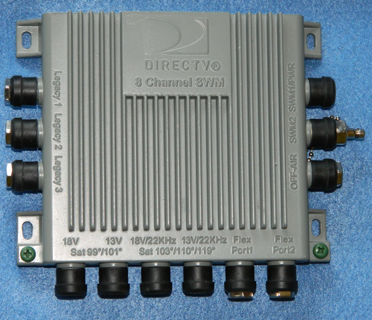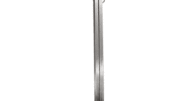The other day, I was talking to one of the Signal Pros who answer the phone and we were talking about the SWM-8 multiswitch. In case you’re having trouble picturing one, it’s this:

That’s a picture of a SWM-8 that I, myself, took about 12 years ago. The SWM-8 multiswitch was released in 2009 as the first-generation of DIRECTV’s single-wire-multiswitch technology. It supported the four signal types from the DIRECTV dish that was standard at the time. It also supported inputs from two other dishes, because at that time DIRECTV used multiple satellite locations for its international programming. With this multiswitch you could support 8 SWM-capable receivers (or 4 SWM-capable DVRs) plus 3 more receivers that didn’t have SWM support. It was a pretty neat bit of tech back oh, about 14 years ago.
But SWM-8 in 2023?
There are still tons of SWM-8s out in the field. They’ve been sitting there for years just working without complaining. They work with every current DIRECTV receiver or DVR, even the Genie 2. (I’ve done it, so don’t tell me it can’t be done.) But should you keep using it? That’s the real question of this article.
I think that it’s important not to throw away things just because you want something new and shiny. A device like this, properly disposed of, will get stripped for its precious metals (of which it has very few) and then the rest will be recycled. Or that’s the idea. A lot of electronic waste just ends up in giant piles in another part of the world.
But on the other hand, sometimes it makes sense to upgrade things before they break. Sometimes a new device brings new capabilities, like the SWM-30 that replaced this SWM-8. It supports DIRECTV’s reverse band broadcasts and with the right receiver you can hook 30 of them to one multiswitch. If you’ve been using 4 multiswitches to do that in the past, you could be saving a lot of space and even using less energy.
Plus, if one of those multiswitches fails, you have two options. You can rush to upgrade the entire system at a time that might not be good for you. Or, you can buy a used SWM-8. All the SWM-8s that ever existed in the world were made between 2008 and 2010. They’re all aging, and they will all eventually fail. Shouldn’t you upgrade when you can plan for it?
There’s no one-size fits all strategy
I have things in my house that have been there for 30 years and they work great. If they broke I’d be unhappy but I’d admit they lived a good life. On the other hand, I have things that failed at the worst possible time and I had to spend a lot of money to get them fixed fast. And then there are things like my phone, which I tend to upgrade every other year or so because the new phones are just more capable.
So as you can see even one person can have multiple strategies for knowing when it’s time to upgrade something. Here’s what I use to try to decide:
How long can you live without it and how much more would it cost to replace it quickly?
If my furnace failed in the middle of winter, I couldn’t live without it. I’d need to pay someone a lot of money to put in a new one. And realistically it’s going to fail in the winter, because no one uses a furnace in the summer. On the other hand, if my oven failed… well I’d be annoyed but I’d use the microwave or eat out for a couple of weeks while I chose a replacement.
When I’ve had a phone for a few years, well you know what happens. Battery life starts declining fast. Operating system upgrades stop going smoothly. And sometimes, weird stuff starts to happen. Plus, no matter how careful I’ve been, the outside of the phone shows its age as well.
Like you, I rely on my phone and I wouldn’t want to have to drop everything and get a new one in a rush. Even though there’s a phone store on every corner and I literally work for a company that sells phones, I don’t want to be under that much pressure. So I upgrade when I’m ready and when I can afford it. And then, a few years later, I start again.
By upgrading that way, I can pass that phone along to someone who might not need as much battery life as I do or who just wants to pay for a cheap phone. So I feel better about it than I would if I just used the phone until it flat out broke.
What’s your take on this?
I’d be curious to see how often you upgrade your equipment, especially your home theater equipment. Of course you know you can go to solidsignal.com to get the same equipment that installers use, or you can call us at 888-233-7563 to ask whatever questions you need. You can even plan for a completely new install, in plenty of time for you to get it done right. Who knows… this might just be the perfect time for it.




